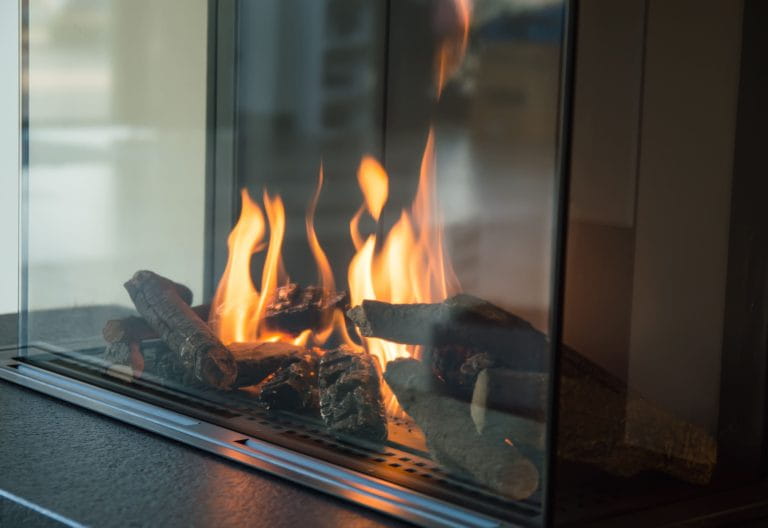The thermo fireplace is one of the heating systems alternatives to the boiler. It works to heat rooms and produce domestic hot water, and it can operate on both wood and pellets. The new versions also offer excellent aesthetic solutions. Let’s discover together how it works and evaluate the advantages and disadvantages.
What is the difference between a fireplace and a thermo fireplace?
The thermo fireplace is a home heating solution that, at first glance, resembles traditional wood stoves and fireplaces, taking the user back in time when these were an essential element in homes: not only for their functions but also as a gathering place and a focal point of domestic life.
It is designed and engineered to be connected to the existing heating system, such as radiators or underfloor heating. Additionally, it undeniably brings a charm that makes the home environment more welcoming.
The thermo fireplace, on the other hand, manages to recover the heat generated by combustion. This is made possible by its composition.
- A tempered glass isolates the flame from the outside.
- The combustion chamber has a cavity which contains water which is heated by combustion.
- The heated water is used to heat the radiators and produce domestic hot water.
It is the technologically advanced and avant-garde version of the classic fireplace.
Depending on the type of power supply, you can opt for:
- wood-burning fireplace;
- pellet fireplace;
- hybrid fueled fireplace with the alternating use of wood and pellets.
The heat propagation may also differ:
- by air, the heat is distributed through vents;
- by water, it works in a very similar way to a boiler, heating the rooms by passing the water through the radiators.

How much can you save with a thermal fireplace ?
Evaluating the actual economic impact of this kind of heating system is not easy. Estimates indicate energy savings ranging from 30% to 50%, but some factors must be taken into consideration.
Among these we find the consumption of wood or pellets which depends on:
- the heating power of the fireplace stove;
- the performance of the fuel used;
- the characteristics of the building to be heated such as, for example, its thermal insulation.
In the last period the price of wood has recorded a considerable increase before a greater demand. To keep costs down, you can rely on low-cost wood which, however, does not often coincide with quality wood.
It is hardwoods that perform most during combustion with their higher calorific value. A better performance corresponds to a higher price.
As for pellets, the cost of this raw material has also fluctuated upwards.
We also consider that a thermo fireplace with air heat propagation does not produce domestic hot water. Its installation can generate savings for space heating, but requires a boiler which compensates for the absence of the first.
Maintenance and cleaning of the chimney must be conducted by a skilled technician: these two activities are fundamental for the safety of the household inhabitants.
- It is necessary to ensure that there are no materials or obstacles of any kind that can limit the airflow, even partially.
- There should be no foreign materials present, especially if they are flammable, dusty, or of any other type that could pose a danger, hinder, dirty, or clog the airways of the appliance.
In the cost category related to thermo fireplaces, we find electricity: most models require it to function correctly, although the primary heat source is the combustion of wood or pellets.
Electricity is necessary for several components and functions:
- Circulation pump. Hydrothermal thermo fireplaces have a pump to transmit hot water from the appliance to the radiators. This pump requires electricity to operate.
- Ventilation system. Some models of thermo fireplaces include a fan to help distribute heat in the environment or to optimise combustion within the combustion chamber, powered electrically.
- Controls and sensors. Many modern thermo fireplaces are equipped with electronic control systems that regulate the temperature, monitor performance, and ensure safety. These systems include thermostats, temperature and oxygen sensors, and function control displays.
- Automatic ignition. The most advanced models may have an automatic ignition system that requires electricity to be activated.
Therefore, electricity plays a crucial role in supporting and optimising its operation. During a power outage, some functionalities of the thermo fireplace may not be available, although the heat from wood combustion may still be used in a limited manner.
How much does a good fireplace cost?
A thermo fireplace guarantees an aesthetic impact. It creates a feeling of comfort and intimacy that spreads throughout the environment in which it is inserted. It recalls the romance and atmosphere of traditional fireplaces, but is much easier to clean.
The tempered glass that delimits the external part prevents dust and ash from dispersing. The fact that the hearth is structurally separated from everything around it reduces the risks deriving from the spread of fire and smoke.
Even the maintenance of the combustion chamber and the flue is not complex, except for unforeseen events.
On the other hand, the initial investment can be substantial. Wood-burning fireplaces have a cost ranging from £1,000 to £3,000.
Water-based thermo fireplaces, in addition, include a special tank. It has a cylindrical shape, is covered with insulating material, and is quite large. Therefore, adequate space is required for proper installation.
- Area assessment. Before proceeding with the installation, a detailed analysis of the area where the thermo fireplace is to be installed must be carried out. It is important to evaluate the presence of an existing fireplace or chimney and determine the most effective position for even heat distribution throughout the house.
- Model. It is essential to choose a thermo fireplace model that suits personal needs and home spaces, while complying with local and national regulations regarding emissions and safety.
- Installation. The installation may require adaptation of the existing heating system, including modifications to the hydraulic system to integrate the thermo fireplace with the central heating system.
- Inspection and certification. After installation, it is highly recommended to have the thermo fireplace inspected by a qualified technician. This step is vital to confirm the correct installation and operational safety of the system.
How is the thermo fireplace connected to the radiators?
To connect a thermo fireplace to the heating system, two pipes are needed:
- the delivery one, which sends the water to the system;
- the return one, which requires a pump that activates the ventilation.
However, the operation also includes the installation of insulated tanks for the hot water of the booster pumps, as well as shut-off valves and minimum and maximum thermostats for a correct temperature regulation.
It is therefore not such a simple procedure, also considering that the closed fireplace requires an independent heating system: this means that if the home already has a system, it cannot be used for the closed fireplace.










































